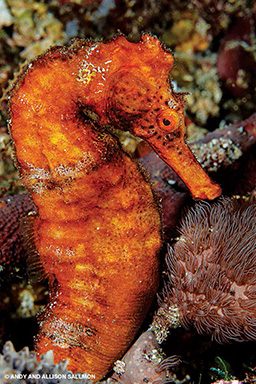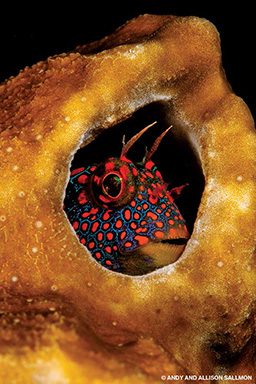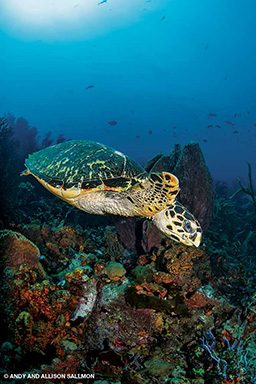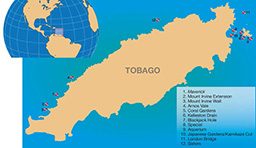
Four hours before our first dive in Tobago, I’m jarred from a sound sleep by an awful screech. Before panic can take hold, the screeching is joined by a cacophony of cackling, chortling and tweeting. I fumble for the clock, groaning about the early hour. The tweeting has tipped me off to the source of the din and provided a shrill reminder of my whereabouts. This island is renowned for its wide variety of bird species, so much so that the Republic of Trinidad and Tobago is considered a must-visit for avid birdwatchers. We might prefer watching fish to fowl, but that hasn’t deterred the cocrico, Tobago’s national bird, from including us in his welcome.
Over the next two weeks, the avian wake-up call becomes as much a part of our day as the faint scent of curry in the air, the melodic lilt of West Indian voices, and soca music (a local offshoot of calypso) blasting from the open windows of passing cars — termed “discos on wheels” by one of our dive guides.
A narrow distance separates Tobago from the coast of Venezuela, a location that places this 116-square-mile island smack in the crossfire of the North Equatorial and Guyana currents. Add the caloric punch of the Orinoco River’s outflow, and you have a powerful combined force that supersizes the corals and sponges and populates them with an array of marine creatures ranging from tiny nudibranchs to giant manta rays, creating a diving experience unlike any other in the Caribbean. As might be expected, this kind of spectacle comes at a cost. Visibility can be limited, surface conditions are often daunting, and swift currents can transmit you from one dive site to the next faster than you can say “supersonic.” Despite these challenges, Tobago has quietly remained on the short list of divers in the know.
The Caribbean
Our boat pulls out of the harbor, passing picturesque white-sand beaches and lively party boats bearing unforgettable names such as “Sweet Lips” and “Swanky.” I turn to our captain and ask, “For tourists?” “Not at all,” he replies. “Those are for everyone — locals, too. We like to celebrate here. You should plan to take a day off afterward.”

Maybe next time. We may be easing into our exploration of Tobago on the mellow Caribbean side of the island, but we have no intention of taking a day off with so much diving to do. Our sights today are set on the Maverick wreck (previously the Scarlet Ibis), a car ferry that was purposely sunk in 1997. The surface is calm, there is no current to speak of, and as we dive into blue, clear water, I allow myself to relax: Perhaps Tobago’s reputation for rough-and-tumble diving is overstated. We hover at 90 feet for the entire dive and inspect the upright bow, which is strikingly covered with sponge, cup corals and crimson sea fans — a move that bores our dive guide nearly to tears. During our surface interval, the exasperated young man gives us a bit of advice: “The bow is nice, sure. But believe me, the stern is much better. Let’s go again.”
As we descend near the stern mooring line we notice something odd: The wreck appears to be moving. A few feet deeper the scene comes into focus. The back end of the wreck is swarmed by a shoal of sweepers. Hunting jacks patrol the edge of the school, periodically darting into the mass and dividing it into panicky silver whorls. I turn back to our dive guide delightedly, and he points at me, a hand symbol I interpret as, “Told you so.” When you’re right, you’re right. Back on the boat I’ve barely spit out my regulator before I’m begging for a next-day return to the stern of the Maverick.
Reports of unmanageable conditions prevent us from visiting the popular dive sites at the southern tip of Tobago, but the crew has a backup plan. Our guide has recently seen squadrons of eagle rays at Mount Irvine Extension, and we decide it’s worth a look. The sloping hard coral reef drops to 80 feet before leveling off at the sand, and we swim slowly alongside the edge, staring hopefully into open water. Nothing. The visibility has tanked and is worsening by the minute, giving the water an eerie feel that isn’t exactly boosting my mood. I’m starting to give myself an attitude adjustment speech (“the ocean is not a zoo”) when I notice two odd things: Our guide is waving his arms maniacally, and my buddy is hurriedly adjusting his camera settings. I squint into the distance and adjust my own camera in hopes of an eagle ray. The ray that appears, however, is a lovely 9-foot-wide manta, which — unlike an ungrateful diver I could mention — is perfectly content with the plankton-filled water. It approaches us slowly, circling closely for several minutes before departing into the green-blue deep.

When we surface, we are elated. Despite decades-old tales of Tobago’s abundant manta rays, they are now spotted mainly at a few dive sites, and even there sightings are considered lucky. We timed our trip to overlap the springtime full moon in the hopes of optimizing our chance of manta encounters (sources indicated that our odds would be best between January and May), but we hadn’t dared to bring up the M-word since making that decision. Our guide enthuses, “Really, the Sisters [an offshore dive site] is the best place to see them. But here? I won’t say never, but, well, pretty much never!”
Seasonality, moon phase, providence — whatever the reason for our manta sighting, a continued decline in visibility means any additional mantas would practically have to slap us in the nose before we saw them, so it’s an ideal time for a change of pace. Fortunately, the Caribbean coast of the island is a haven for unusual small marine life. We spend a mellow dive inspecting Mount Irvine Wall, where every nook and cranny is occupied by a blenny, arrow crab or shrimp, though our diligent search never uncovers the frogfish or shortnose batfish sometimes seen here. At nearby and equally tame Arnos Vale, we lose count of the cowries climbing the sponges and soft corals, and the local nudibranch population has been busy as evidenced by an explosion of green Elysias gorging themselves on the rocks.
At this point I’ve developed profound appreciation for waterborne nutrients in Tobago, but I’m questioning the island’s reputation for strong currents. In an ill-advised moment of overconfidence, I make a flippant remark about fear-mongering to our dive guide, who replies, “Aren’t you going to Speyside next?” He looks at the boat captain, and the pair erupts in hysterical laughter. I chuckle uncomfortably and then refrain from making any more jokes for the remainder of the day.

Speyside
Halfway through our first dive in Speyside I’ve determined I should keep my mouth shut. We are at Coral Gardens, a site on the Atlantic side of Little Tobago, and the current is ripping. The visibility, however, is spectacular, so I am swimming for all I’m worth to photograph the incredible scene before me. Elephant ear and twisted barrel sponges rest on a backdrop of rope sponges with no dead space in between. Green and hawksbill turtles pass lazily through schools of wrasse and snapper as reef sharks patrol in the distance. When I can no longer kick against the current, I let it whip me past the Dali-esque seascape. Ultimately arriving at adjacent Kelleston Drain, we pause to examine what is said to be one of the largest brain corals in the world (16 feet across) before ascending. When the boat picks us up, we are nearly a mile from our drop site.

It is soon evident that Speyside divers revel in the thrill-ride nature of the area; it’s to the point that a site with a 2-knot current seems unremarkable for a checkout dive. This tiny corner of islands and wash rocks delivers more excitement per square foot than any amusement park.
At Black Jack Hole, we are shuttled from a fish-swarmed, current-swept point to a spectacular reef with an invigorating intermission: a surgy coral stadium where we watch tarpon and black jacks hunt in the surf overhead while trying to avoid getting tossed to the surface or disturbing the turtles and nurse sharks napping under the reef edge. At TDE Special, we are whisked at warp speed from an incredible reef around a stunning corner covered top to bottom with wide-open, neon-bright tubastrea.
Other sites, such as Aquarium and Japanese Gardens/Kamikaze Cut, begin with the ubiquitous Tobago tangle of sponges and gorgonians and end with narrow passages through which an already brisk flow funnels and accelerates. At both sites, efforts to fight the current are so futile that our only option is to protect our kneecaps and cameras until we’re spit out on the other side. Then we kick like hell to see what marine life is tucked under ridges near the passages’ exits. And nearby London Bridge, distinguished by a rock arch that rises above the ocean’s surface, adds to the pervasive current and color an auditory bonus: a thundering boom whenever a wave hits — which is often. Actual dive briefings included gems such as, “We have to be on the same page here: You absolutely cannot surface in the middle of this site” and “Please try not to get sucked into the washing machine.” On the surface, 6-foot swells and sustained 20-knot winds are considered average, which means eardrum-squeezing, dome-port-threatening surges are nearly everywhere we dive.
It is utterly exhilarating. Our days become a euphoric 2+-knot blur of color and marine life that we never imagined existed in the Caribbean. We are so exhausted that 8 p.m. bedtimes become obligatory, and we sleep easily through the island’s predawn bird symphonies.

On our final dive day, we’re headed to the Sisters, a series of pinnacles off the northwestern coast of Tobago that boasts the highest number of big animal sightings in the area. Our guides tell us that just last week a huge manta shadowed divers closely for the entire dive. Other denizens include scalloped and golden hammerhead sharks as well as large schools of jacks. Getting to the Sisters from Speyside requires a trip around the northernmost point of the island where swells stack up, reaching daunting heights, so relatively placid conditions are a must. When we arrive, the 7-foot swell doesn’t seem terribly placid to me, but I count at least four miniscule boats, each containing a (possibly insane?) solitary fisherman, which suggests otherwise.
The water is hazy and green, and I immediately accept that the chance of spotting any large fish in the distance is slim. Since it’s tough to look away from the coral-studded rocks here, I determine that the marginal visibility is a bonus: I can now concentrate on what’s in front of me. It’s not hard to do since within 10 minutes I’ve seen two hawksbill turtles, an unbelievably fat green moray and a cluster of lobsters as big as dogs. We pass walls covered with tubastrea and jumbles of sponge and more walls layered with stubby red, yellow and purple sea fans. Strong surge combined with an equally strong desire to surface with an intact camera system prevents me from taking many images, but I am content to clip off my camera and enjoy the view.
After the dive our grinning, dreadlocked captain spots us easily in the swell and heads our way. Local soca music blasts from the bridge — a disco on water. As the boat pulls alongside us, the song’s lyrics are audible over the crashing waves: “I was born in a perfect place,” the local artist intones proudly. I’d have to agree.
Diving In: Tobago
Getting there: Many international airlines fly to Port of Spain, Trinidad (Tobago’s sister island). From there, Caribbean Airlines runs “air bridge” services to Tobago. Regular ferry service also exists between the two islands.

Seasons, water temperatures and exposure gear: Tobago lies outside of the hurricane belt, but conditions depend on seasonality. The dry season (December to June) brings the best chance of good visibility (up to 100 feet). During the wet season (July to November), outflow from the Orinoco River and runoff from the island can significantly decrease visibility; though the freshwater layer will often remain at the top of the water column, allowing for clearer (if darker) conditions at depth. Water temperatures generally range from 78-83°F (highest in summer and early autumn). Due to surge and current, a full 3mm wetsuit is recommended.
Skill level and conditions: While conditions at some sites on the Caribbean side are more suited to novice divers, and very few of Tobago’s dives compel divers to exceed a depth of 85 feet, much of the diving here is best suited for advanced divers. Topside conditions can be challenging. The strong surge and current are great reasons to enlist the help of local dive operators during your visit. A surface marker buoy is highly recommended. A hyperbaric chamber is on the island.
© Alert Diver — Q3 Summer 2015